Skating in the work of Rembrandt and the difference between Rembrandt and Avercamp
Nelly Moerman, author
Cis van Heertum, English translation
Rembrandt van Rijn (1606-1669) has been the subject of a number of exhibitions in several countries in recent years. Their themes ranged from his relations with other famous painters to the work he produced in the various stages of his life. This wide array of topics generated great public interest. There is one topic, however, which has received relatively little attention: Skating in the work of Rembrandt.
Library search
A great deal has been written about Rembrandt and his work, but there is relatively little to be found about skating. A search of the National Library of the Netherlands catalogue yields 2,048 hits when entering ‘Rembrandt' in the search bar (search date 4 Sept. 2019). If we combine ‘Rembrandt’ with ‘skates’ or ‘skating’, there are zero hits. The same search in WorldCat yields the vast number of 59,070 items for ‘Rembrandt’, but only nineteen items when ‘Rembrandt’ is combined with ‘skating’ or ‘skates’. Why has there been so little interest in this subject so far? The painter lived at a time of severe winters when fun on the ice was popular entertainment. Paintings of winter landscapes with ice and skaters, also known as Wintertjes in Dutch, were in great demand and were produced in vast numbers. Many painters, Hendrick Avercamp (1585-1634) for one, were able to make a living out of them. Rembrandt preferred another genre, he painted portraits and history paintings. In his entire oeuvre there is only one small painting of a scene on the ice with skaters. He is also known to have made two small etchings featuring skaters. The etchings will be dealt with in Rembrandt’s skating etchings and the development of visual tradition; the present article focuses on the painting.
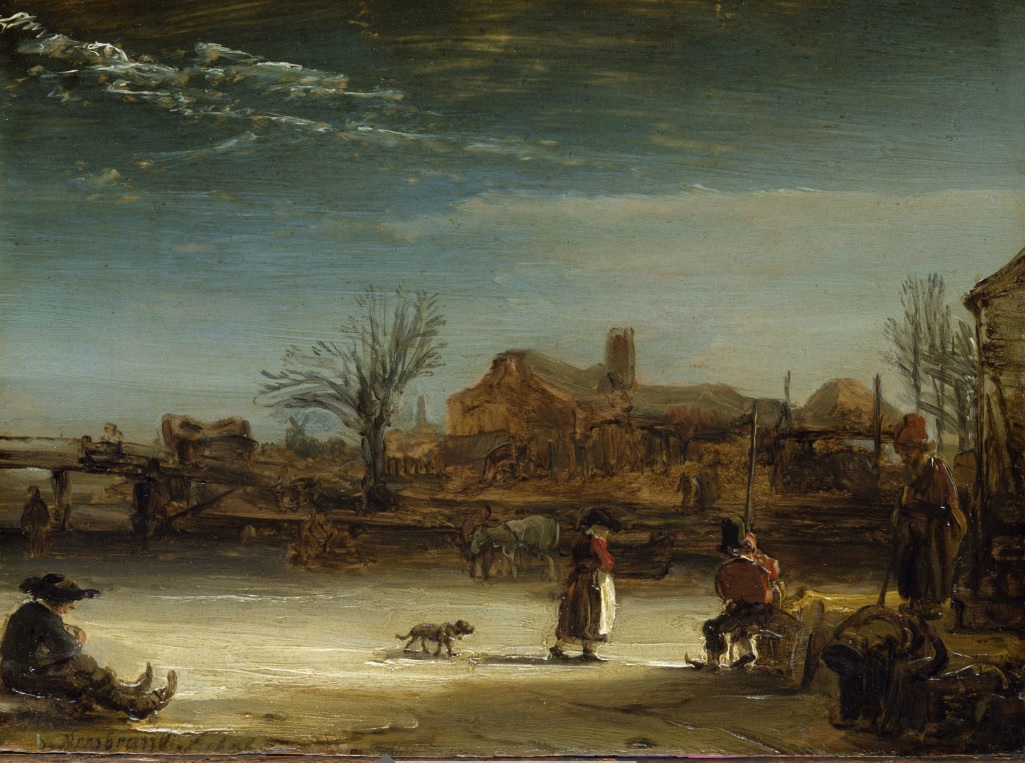
Winter landscape with skaters
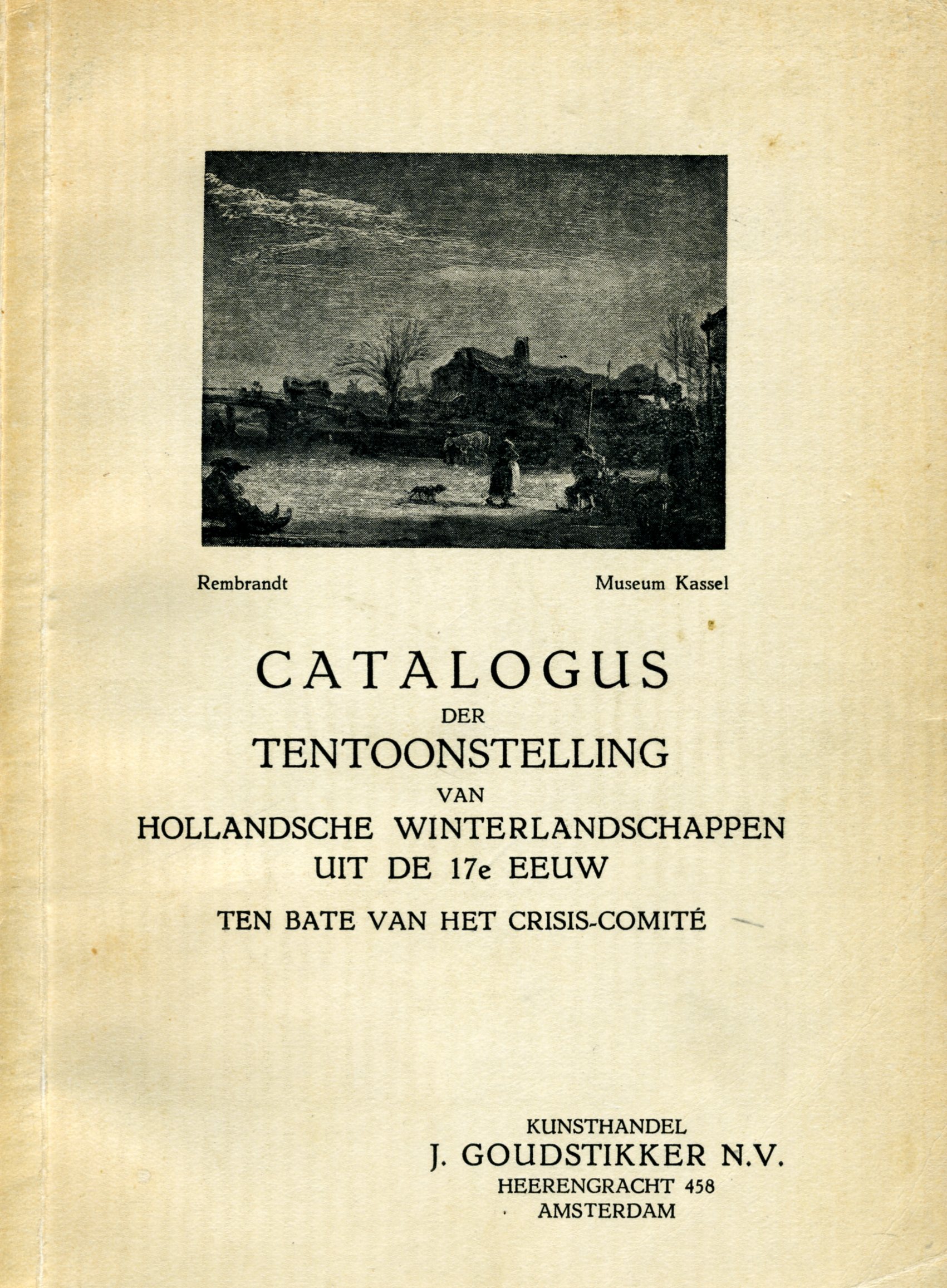
The painting in question is an oil on wood panel showing a winter landscape, signed and dated 1646. The painting measures 16 by 23 cm, slightly larger than a half A4 sheet. (fig.1 painting) The panel is part of the collection of Museum Schloss Wilhelmshöhe in Kassel, Germany. Landgrave Wilhelm VIII von Hessen-Kassel acquired the painting from an art dealer in The Hague in 1752. The panel was kept at the Musée Napoléon in Paris for some eight years (1807-1815) in the Napoleonic era, after which it was returned to Schloss Wilhelmshöhe. The painting is a popular object for exhibitions because of its atmospheric quality. Requests to borrow it, however, were not always successful. The Dutch art dealer Jacques Goudstikker, for instance, who organized a fundraising exhibition of 17th-century Dutch winter scenes in 1932, a time of economic crisis, was unable to borrow the small panel from Kassel. To compensate for this ‘missing link’, as he described it, he included a photograph of the painting on the cover of the catalogue. (fig.2)
Museum Schloss Wilhelmshöhe
The painting can be viewed online on the website of Museum Schloss Wilhelmshöhe. A great advantage of online viewing is that it allows a close study of details. The much acclaimed atmospheric quality of the painting, however, is difficult to capture in a reproduction. Its charm can only really be felt when it is actually seen close up. I have been lucky to have had this experience several times.
Museum Schloss Wilhelmshöhe is well worth a detour. Kassel is situated some 300 km east of the Dutch city of Arnhem and some 200 km north of Frankfurt am Main. When there are no special exhibitions, the beautifully located museum breathes an air of pleasant peacefulness. If you visit on the right day the Cascades in the park are active, a wonderful spectacle with a 50-metre high fountain at the base.
The atmosphere of a cold winter’s day
 - kopie.jpg?1569780871553)
Rembrandt’s small ice scene is composed of horizontal bands of alternating light and dark. The foreground is dark, with a light band above in which the ice is illuminated by the light of a low sun coming from the right. The sun itself is not visible. The next horizontal band is dark and is formed by a river bank outlined by a farm, a haystack and bare trees. On the left a road leads to the bridge and out of the picture. On the right the painting is framed by a wooden building. Above this dark band there is another light band, a stretch of bright blue sky. At the top the sky has darkened and the clouds are indicated by white highlights. The blue sky especially evokes the atmosphere of a cold winter’s day. (fig.3)
Painting signed and dated
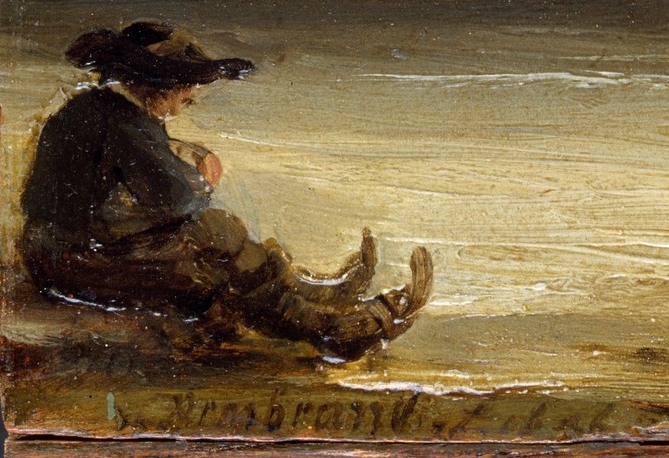
The people in this winter landscape are arranged in a natural way. The most striking figures are the woman in the middle with a dog walking behind her, while skaters on the left and right also catch the eye. The skater on the left bank is resting with his legs outstretched. He still has his skates tied on, as if he is planning to get back on his feet any minute. Underneath, along the lower edge of the panel, Rembrandt painted his name with the addition of an italic “f.”, the abbreviation of fecit, to indicate that he made the painting himself. (fig.4) The year 1646, too, can be made out with a little effort. Two people can be seen above the resting skater in the left of the painting. A man is walking on the ice and someone is watching from the bridge.
Man with donkey and box sledge
To the left of the woman walking on the ice, in the dark part of the bank, a man is busy with a donkey and a box sledge. (fig.5) By enlarging the image it is immediately clear how Rembrandt manages to create a standing figure with only a few strokes of the brush, almost as if he was sketching. (fig.6) The donkey has been depicted in greater detail. The animal has a feedbag and a cover to protect it against the cold. On the right bank a bearded man wearing a red cap is surveying the scene while leaning on his stick. In the dark part below him yet another figure can be made out who is busy with his skates.
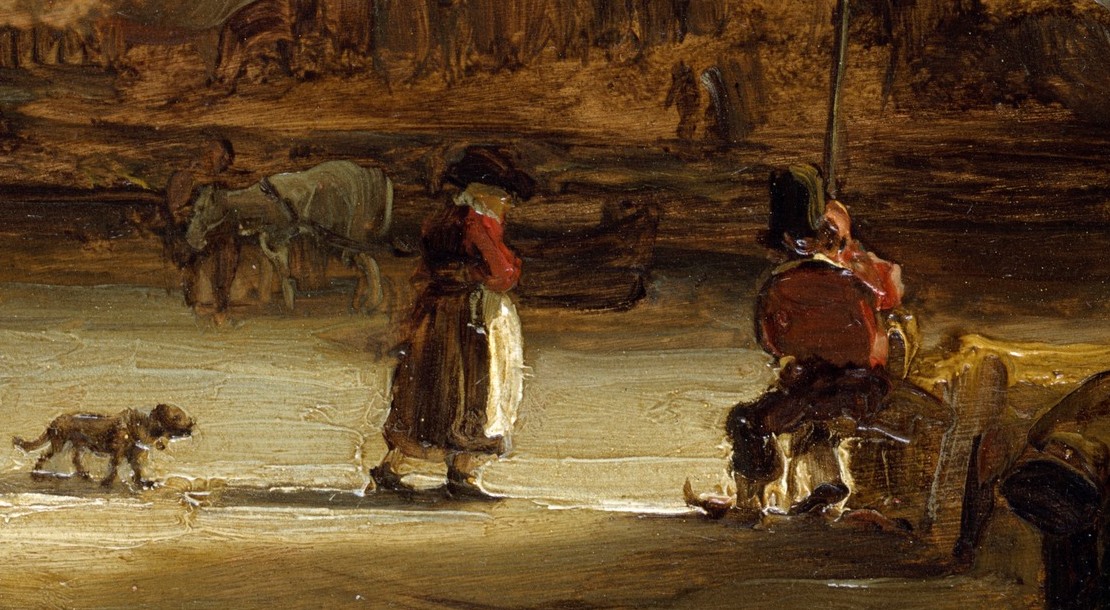
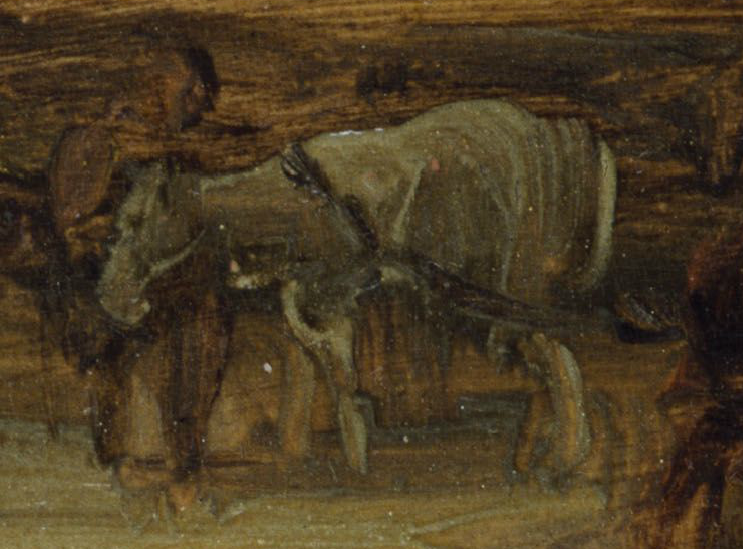
What about the long stake behind the couple?
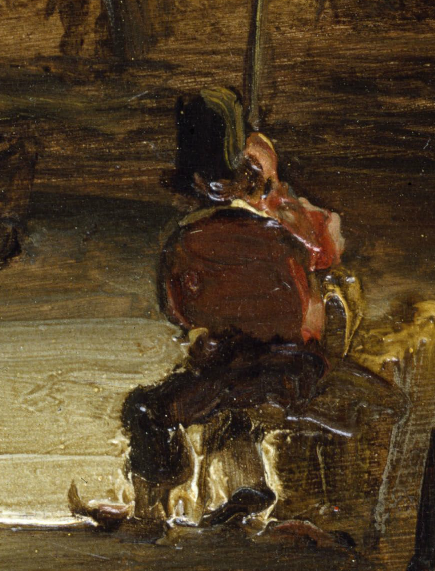
The woman who is followed by her dog is walking towards a man who has been described as a skater seated by the side of a long pole. One author writes that “the man is holding the long stick upright”, another one believes he is “leaning against a pole”. Is this correct, however? An entirely different interpretation suggests itself by strongly enlarging the image. (fig.7) When the visible top part of the pole is extended downwards, it does not end in the vertical shade near the man’s lower legs. If we place a ruler alongside the object, it becomes clear that they are two different things. It cannot be a stick which the seated figure is holding or a pole he is leaning against. What, then, is the story here?
Man and woman pleasantly seated together
I believe the situation needs to be viewed differently. A woman dressed in red is seated next to the man and the pole or stick is standing upright at some distance behind them, like a mooring post frozen into the ice. The man and his female companion are facing each other, and her red outfit catches the last rays of the sun. The man is seen from the back and largely remains in the shadow. Only his right shoulder and the right side of his high hat catch some light. It is unclear what precisely the two are sitting on. It could be a little boat or perhaps a wooden landing. Contrary to what is generally claimed, the man is not wearing skates. This is very obvious if we look at his right foot. The front foot is leaning on the ice and the heel is detached from the surface. The left foot, too, clearly does not have a skate fastened on. The direction of the sole does not align with the upper surface of the skate lying in front of him on the ice. Loose skates lying on the ice can mean two things: the skating party is over or has yet to begin. In this case it would seem that the two have just been skating pleasantly and that the woman followed by her dog is approaching as if to join them.
Rembrandt: master of colour and light
Rembrandt decided to depict the dress of the seated woman in a warm red colour. Red is a striking colour, it has movement and it comes to the fore. The man standing on the bank would have merged with the background had he not been given a red cap. Unlike red, blue is a cool colour that recedes. This is clearly visible from the blue in the lower layers of the atmosphere, where the sky stretches away to infinity. Colour can thus be a way to structure a painting. That the attention is drawn to the couple with skates, however, is not only because of the colour but also because of the light. It comes from the right, the woman is sitting in the sun, the man sitting next to her is portrayed with his back towards us and he hardly catches any sunlight. Their shapes are clearly outlined, however. Rembrandt, who gained great fame as a master of light, applied a ‘trick’ here. He used the reflection of the ice as a light source. She is sitting in the sun against a dark background, he is sitting in the shadow but is illuminated by the light reflecting from the ice. This interplay imbues the scene with a controlled dynamic quality. Colour and light make clear what the painting is about.
Hendrick Avercamp and his young couple
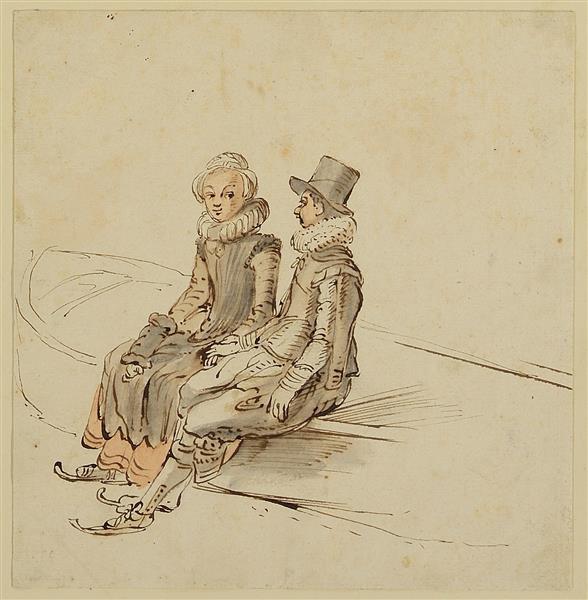
How would Hendrick Avercamp have gone about a scene like this? Avercamp also saw a couple sitting cosily together on the edge of a small boat. (fig.8) The drawing (15 x 15 cm) is part of the collection of the Gemäldegalerie Alte Meister in Dresden and can also be viewed online. The vantage point of the drawing is such to suggest Avercamp was standing on the ice himself. The drawing was executed in pen with brown ink and worked up with brown, grey and red watercolours. Avercamp manages to capture an intimate moment. The girl has taken her left hand out of her muff and allows her companion to cautiously put his hand on hers. They are looking at each other and their faces reflect the thrill of the moment. Avercamp depicted the dress, ruffs and headgear down to every detail. The skates, too, have a distinct shape, having a long neck and ending underneath the heel. Nowadays they would be called Frisian skates.
Rembrandt and Avercamp: painter versus draughtsman
What is the difference between Rembrandt’s painting and Avercamp’s drawing? Rembrandt surveys the overall picture. His vantage point is at the height of the standing man wearing a red cap. We could even imagine Rembrandt having stood on a bank as a spectator. Avercamp moves in closer, he zooms in on his subject. He may also have taken part in the fun on the ice and may be standing on skates. Both artists witness something beautiful happening between two people. Avercamp draws precisely what he sees and manages to capture the girl’s gaze well. He draws a picture that is as detailed as possible. The skate is realistically drawn and the type can even now be determined. Rembrandt worked almost as if he was sketching, without too many details. Rembrandt’s skate is no more than a suggestion, though it is a suggestion that has been created in a masterful way and with no more than a few strokes of the brush. Some readers may think it is impossible to compare a painting with a drawing. This is partly true. Using the two illustrations as a basis I have tried to make clear how different the two artists are. Rembrandt created a painting that expresses the tranquil, cold atmosphere of a winter day. The painter structures the representation, emphasizing essential elements through light and colour. Avercamp manages to reflect the emotion of the moment in his drawing. If we turn to his paintings, however, he is far less spontaneous. Tradition and a set composition provide the fixed framework for his figures. Rembrandt and Avercamp both know how to fascinate the viewer with their representation of an ice scene. This is what they have in common. The great difference is that Avercamp remains a draughtsman, even when he paints.
References
1) Rembrandt in Kassel: http://altemeister.museum-kassel.de/33764 courtesy of Staatliche Museen Kassel, Gemäldegalerie Alte Meister.
2) Avercamp in Dresden: https://skd-online-collection.skd.museum/Details/Index/889924 courtesy of Staatliche Kunstsammlungen Dresden, Kupferstich-Kabinett.
3) C.J.J. Vogelaar, G.J.M. Weber, Rembrandts Landschappen, Leiden/Zwolle 2006, Cat. no. 6, pp. 93-101, 132-137, 204.
4) Erik Hinterding, Licht. In: Catalogue of the ‘Late Rembrandt’ exhibition, Rijksmuseum Amsterdam 2014, pp. 173-191.
Source
This article is a revised version of an article published in Kouwe Drukte 2015; no. 54, pp. 28-32. [ISSN 1572-4476]
© Nelly Moerman 2015, 2019
This article is protected by copyright. Reproduction of the text, in whole or in part, is permitted only on an individual basis and under the conditions of acknowledgement of source and correct citation. In case of a financial interest or the pursuit of such an interest, copying is not allowed. In case of doubt, please contact the author, who can be reached through redactie@schaatshistorie.nl.